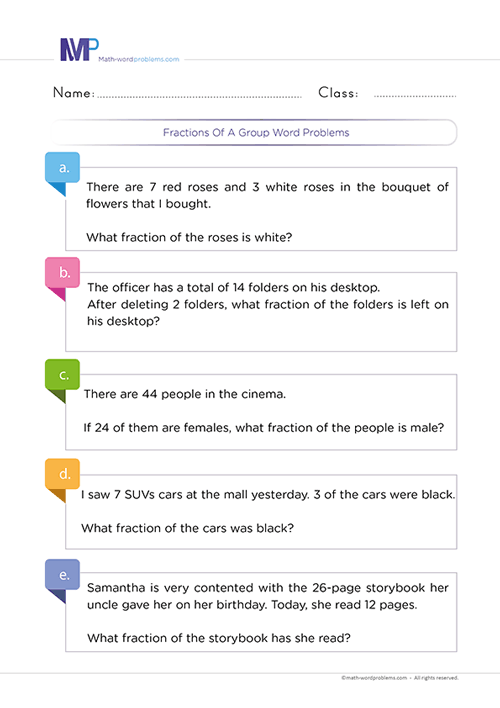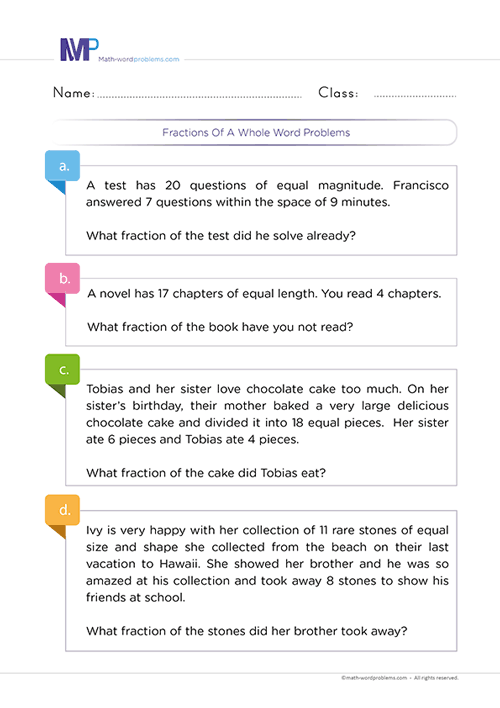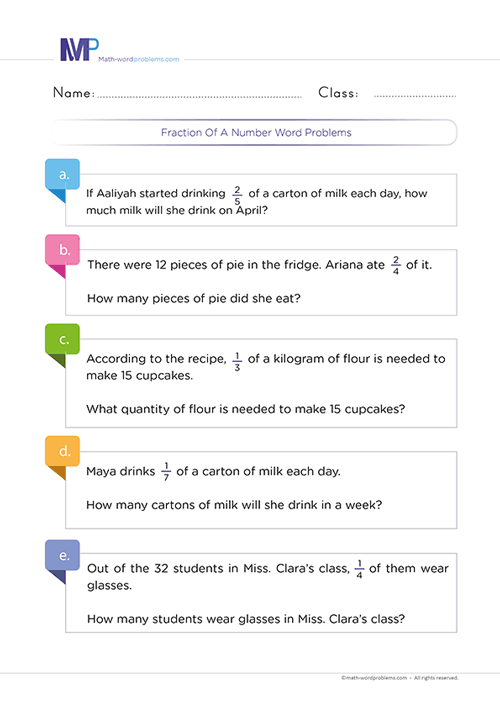 How to solve fractions of a group word problems
How to solve fractions of a group word problems

- INTRODUCTION
- Step 1 Identify
- Step 2 STRATEGIZE
- Step 3 SET UP
- Step 4 PROVIDE A SOLUTION
- Step 5 CHECK YOUR WORK
Get more contents on this skill...
The best way for 3rd graders to know how to solve fractions of a group word problems is by following our unique step-by-step guide keenly. This magnificent step-by-step guide consists of outstanding tips and strategies, from identifying the problem type, strategizing and determining the operation, setting up a number sentence, then solving the problem accurately.
This, with this guide, your kids will become experts in solving fractions of a group problem and other fraction concepts in less time.
Also, after going through this guide on how to solve fractions of a group word problem, your kids can make sense of maths problem-solving by focusing on unknown solution procedures. i.e., by applying visual representations and expressing mathematical thinking via discourse ( in this case, interpreting or retelling the problem in their own words).
Steps to solve fractions of a group word problems
Below are simple steps to solve fractions of a group word problems using instructional components such as visual representation, explicit, systematic instructions, heuristic techniques, and sequence of examples. These steps will significantly upgrade kids' fractions of a group word problem-solving skills.
In addition, to motivating and helping kids follow our step-by-step guide on how to solve fractions of a group word problems attentively, we have included some real-life situation examples to show them how these steps work.
Step 1 IDENTIFY THE PROBLEM
To identify the problem,
- You can begin by studying/reading out the problem carefully to understand it,
- Then, identify and highlight relative statements,
- Now, reread the problem and try to find out any important numbers and keywords
For example, the only common keyword you need to look out for in fractions of a group is “What fraction of” and if the word problem consists of a part and a whole.
Note: learners should understand that it would be best not to rely entirely on keywords alone because a particular keyword can have different meanings in different word problems.
In that case, you need to read the question very well to understand the situation the word problem describes. After reading, you will also find out if the problem makes sense first before determining which operation you need to use.
Step 2 STRATEGIZE AND DETERMINE THE OPERATIONS
At this point, this question will help, “How will I handle this problem?”
Here, you will apply the read-to-understand rule. i.e., you have to read the word problem and try to interpret it in your own words.
Since each word problem may require a different solving format, the key points below will enable you to tackle any word problem irrespective of the format.
- First, the keyword(s) in the word problem will help clarify the operation you need to carry out.
- Although, relying on keywords alone to solve word problems has some limits, as mentioned in step 1 above.
- So, because of this, you must first read the word problem to understand the situation that the problem is describing.
- Reading the problem to understand will lead you to be able to identify the problem type and relative statements in the word problem, which, together with the keyword(s) in the problem, will determine the correct maths operation that you need to use
To grasp fractions of a group quickly, you’ll have to understand some primary language used in fractions like:
- Part, also known as the numerator, is the top number in a fraction. The numerator tells us how many pieces we are dealing with.
- The whole, also known as the denominator, is the bottom number in a fraction. The denominator describes the size of the pieces.
Step 3 SET UP A NUMBER SENTENCE AND AN EQUATION
- After knowing which operation you will perform from step 2 above, construct short sentences to represent the information given in the word problem,
- These short sentences represent the vital information that makes it easier to solve the word problem. In order words, it is like a diagram of the word problem,
- Then, you can deduce a solvable maths equation to represent the information given in the phrases you constructed above,
- In addition, use “/” to separate the numerator from the denominator;
Step 4 SOLVE THE PROBLEM
From step 3 above, simplify the fraction if need be. In addition, always recall to include the unit of measurement in your final answer.
Step 5 VERIFY YOUR ANSWER
Finally, check your work to make sure that your answer is correct. For instance, since you are dealing with only numbers and not algebraic expressions, it is good to use reasonableness by estimation to see if your answer makes sense.
Therefore, if you estimate and the answer is close to what you have, your answer is correct. However, if your answer is beyond reasonable limits, you must go back to step one and start again.
Examples of how to solve fractions of a whole word problems
Example one: solution a
- What fraction of the fruits are apples?
- What fraction of the fruits are watermelons?
- What fraction of the fruits are oranges?
Step 1: Read the problem and underline all the relational statements. So, after reading the problem very well, you’ll come across the essential numbers 7, 2, and 1. The keyword found in the word problem is “what fraction of...”
Step 2:Now, the question is, "how will you solve this problem"? Which is the whole, and which is the part?
At this stage, you need to reread the problem and interpret it in your own words to come out with the correct operation without necessarily depending on the keyword.
The problem is telling you Mirable has a certain number of different kinds of fruits, namely apples, watermelons, and oranges.
Now, the problem wants you to find the fraction of the fruits that are apples.
Now, “which operation can I use to find the parts of a group (a whole) of objects or things?”
Back to the given problem, the part is the number of apples, and the group of things is the total number of fruits.
So, from the problem described, from retelling the problem in your own words, and from the keyword found in the word problem, it shows that it is a fraction of a group problem.
Step 3: Construct short sentences representing the most vital information in the word problem.
Now, after knowing what the part (numerator) and the whole (denominator) will be, you need to translate the bolded sentence below into an accurate, solvable math equation.
Also, use “/” to separate the numerator from the denominator.
- Number of oranges that Mirabel has = 7
- Number of apples that she has = 2
- Number of watermelons that she has = 1
- The total number of fruits that she has = the number of oranges that Mirabel has + the number of apples that she has + the number of watermelons that she has.
→ 7 + 2 + 1 = 10
- Therefore, the fraction of the fruits that are apples = the number of apples she has as the numerator and the total number of fruits she has as the denominator.
Step 4: From step 3 above, simplify the fraction if necessary. Also, remember to include the unit of measurement in your final answer.
So,
Step 5: Finally, check your work to ensure your answer is correct. Since you are dealing with only numbers and not algebraic expressions, it is good to use reasonableness by estimation to see if your answer makes sense.
So, if you estimate and the answer is close to the one you have, then your answer is correct. However, if your answer is beyond reasonable limits, you must go back to step one and start again.
Example one: solution b
Step 1:Read the problem and underline all the relational statements. So, after reading the problem very well, you’ll come across the essential numbers 7, 2, and 1. The keyword found in the word problem is “what fraction of...”
Step 2:Now, the question is, "how will you solve this problem?"Which is the whole, and which is the part?
At this stage, you need to reread the problem and interpret it in your own words to come out with the correct operation without necessarily depending on the keyword.
The problem is telling you Mirable has a certain number of different kinds of fruits, namely apples, watermelons, and oranges.
Now, the problem wants you to find the fraction of the fruits that are watermelons.
Now, “which operation can I use to find the parts of a group (a whole) of objects or things?”
Back to the given problem, the part is the number of watermelons, and the group of things is the total number of fruits.
So, from the problem described, from retelling the problem in your own words, and from the keyword found in the word problem, it shows that it is a fraction of a group problem.
Step 3:Next, construct short sentences representing the most vital information in the word problem.
Now, after knowing what the part (numerator) and the whole (denominator) will be, you need to translate the sentence in bold below into an accurate, solvable math equation.
Also, use “/” to separate the numerator from the denominator.
- Number of oranges that Mirabel has = 7,
- Number of apples that she has = 2,
- Number of watermelons that she has = 1,
- The total number of fruits that she has = the number of oranges that Mirabel has + the number of apples that she has + the number of watermelons that she has,
→ 7 + 2 + 1 = 10
- Therefore, the fraction of the fruits that are watermelons = the number of watermelons she has as the numerator and the total number of fruits she has as the denominator;
Step 4: From step 3 above, simplify the fraction if necessary. Also, remember to include the unit of measurement in your final answer.
So,
Step 5: Finally, check your work to ensure your answer is correct. Since you are dealing with only numbers and not algebraic expressions, it is good to use reasonableness by estimation to see if your answer makes sense.
So, if you estimate and the answer is close to the one you have, then your answer is correct. However, if your answer is beyond reasonable limits, you must go back to step one and start again.
Example one: solution c
Step 1:Read the problem and underline all the relational statements. So, after reading the problem very well, you’ll come across the essential numbers 7, 2, and 1. The keyword found in the word problem is “what fraction of...”
Step 2:Now, the question is, "how will you solve this problem?"Which is the whole, and which is the part?
At this stage, you need to reread the problem and interpret it in your own words to come out with the correct operation without necessarily depending on the keyword.
The problem is telling you Mirable has a certain number of different kinds of fruits, namely apples, watermelons, and oranges.
Now, the problem wants you to find the fraction of the fruits that are oranges.
Now, “which operation can I use to find the parts of a group (a whole) of objects or things?”
Back to the given problem, the part is the number of oranges, and the group of things is the total number of fruits.
So, from the problem described, from retelling the problem in your own words, and from the keyword found in the word problem, it shows that it is a fraction of a group problem.
Step 3:Construct short sentences representing the most vital information in the word problem.
Now, after knowing what the part (numerator) and the whole (denominator) will be, you need to translate the sentence in bold below into an accurate, solvable math equation.
Also, use “/” to separate the numerator from the denominator.
- Number of oranges that Mirabel has = 7,
- Number of apples that she has = 2,
- Number of watermelons that she has = 1,
- The total number of fruits that she has = the number of oranges that Mirabel has + the number of apples that she has + the number of watermelons that she has,
→ 7 + 2 + 1 = 10
- Therefore, the fraction of the fruits that are oranges = the number of oranges she has as the numerator and the total number of fruits she has as the denominator;
Step 4: From step 3 above, simplify the fraction if necessary. Also, remember to include the unit of measurement in your final answer.
So,
Step 5: Finally, check your work to ensure your answer is correct. Since you are dealing with only numbers and not algebraic expressions, it is good to use reasonableness by estimation to see if your answer makes sense.
So, if you estimate and the answer is close to the one you have, then your answer is correct. However, if your answer is beyond reasonable limits, you must go back to step one and start again.





